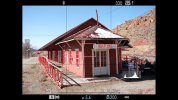I've heard tell about the terrible weather problems in Florida with the heat and sun and I feel for ya. My wife complains about the heat here in the summer but the polar bears can be an issue if you get any further north so we put up with the summer heat too. At least we get a bit of cooling the other 11 monthsUnfortunately , I'm living in the south Florida, It's sunny almost every day. It's never cold, except for the winter nights when it might reach 60 degrees sometimes 50 degrees. Most months are just hot and humid. I suppose I could use a large screen tablet during my night flights though. Maybe I'll buy one next winter season.
You are using an out of date browser. It may not display this or other websites correctly.
You should upgrade or use an alternative browser.
You should upgrade or use an alternative browser.
Power Lines!
- Thread starter DSRT_VLTR
- Start date
N


 I’ve got to admit that I enjoy your videos when you post them.
I’ve got to admit that I enjoy your videos when you post them.
Now that’s a different perspective.I've heard tell about the terrible weather problems in Florida with the heat and sun and I feel for ya. My wife complains about the heat here in the summer but the polar bears can be an issue if you get any further north so we put up with the summer heat too. At least we get a bit of cooling the other 11 months.
Sorry to point out the obvious, but clowns like this flying in close proximity to powerlines, etc.. are why we have RID and bad press in general. Posting to YT is extremely shortsighted trading a little notoriety for a whole lot more negative reactions from those unsympathetic to our hobby.Look but don't touch.
Yikes.
.
Back on topic, as a EMS helo pilot for years, powerlines and abandoned, unmarked lines can be just about anywhere and if you're below a Ridgeline, you're in the wire environment. Don't count on seeing marker balls, there have been plenty of crashes because pilots hit wires that weren't marked.
Last edited:
baddog
Well-Known Member
I had a similar experience many years ago, flying a 3DR Solo Drone with a GoPro camera. It was not until after reviewing the footage, did I realize I was mere inches away from some wires while I was flying along the path of the Erie Canal in NY.
I now, make sure whenever I am flying, I have peaking turned on for all my drones. Although, peaking was not intended for this purpose.
Peaking overlays a red outline on all object edges, in your field of view, on your screen, that are in focus. If you happen to be flying towards a mountain side or dense tree line, those cables and guy wire are almost impossible to see. However, if you have peaking turned on and notice a red vertical or horizontal line, or a straight line at an angle, chances are... that is some sort of cable or guy wire on a tower.
Saved me and my drone many times on the Adirondacks Regions
Example of what peaking looks like (Not my Photo)
Attachments
NightFlightAlright
Well-Known Member
Does anyone know if there is a height limit set by the FAA for power lines?
The height limit for radio towers in the US is 2000’, and remember radio towers have thin guy wires …
The big high tension power lines are commonly 150’ to 200’ high, but can be higher. Highest one is in China, over 1200’ (lines are at 500,000 volts).
In the US, anything over 200’ AGL requires the red lights.
Tolipa
Member
One of the things I was taught when I first started flying helicopters, was to cross power lines over one of the towers. The very thin wire that runs at the top of the wire cluster and runs from tower to tower, is almost invisible, but will absolutely bring down a helicopter. The things you learn when flying big helicopters also applies to little helicopters.
jephoto
Well-Known Member
I’ve got power lines in my neighborhood at 60-120’ and some nearby towers along some commuter rail tracks at 200 or more.No height limit. If I have lines in area, I fly over and drop down on them to check height, then stay above that. If high power they can screw with your radio reception. Something to think about. Normally 100’ will keep you out of trouble.
I launched from the other side of 250’ towers with power lines that run parallel to this expressway. I scout in the area in the daytime before I did any of these nighttime shots. Made sure I knew how high I had to go to get over the powerlines to get the view I wanted.
Attachments
ImpossibleTom
Active Member
Mrprop365
Well-Known Member
This past summer I was flying at a private campus with anafi fpv and I came down to about 7 feet to signal to a friend of mine. I just lost dlos so I went back up, on my way up I flew right threw a triangle of wires, and missed my a couple of feet. A few days later I let a m3 pilot fly and he made a dive assuming he would go under the wires.... He didnt

 . One arm folded in but the drone kept flying, it descended to about 15 feet and then shut down. So what DSRT said is so true
. One arm folded in but the drone kept flying, it descended to about 15 feet and then shut down. So what DSRT said is so true
Very good Advise !One of the things I was taught when I first started flying helicopters, was to cross power lines over one of the towers. The very thin wire that runs at the top of the wire cluster and runs from tower to tower, is almost invisible, but will absolutely bring down a helicopter. The things you learn when flying big helicopters also applies to little helicopters.
Similar threads
- Replies
- 31
- Views
- 2K
- Replies
- 6
- Views
- 1K
- Replies
- 2
- Views
- 572











